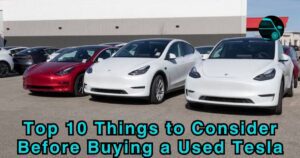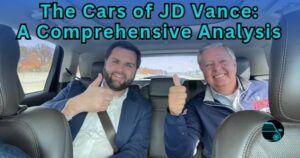The automotive world is on the cusp of a monumental transformation, driven by the rise of autonomous driving technologies. One of the most ambitious efforts comes from Tesla, which has plans to launch a fleet of robotaxis. This concept, first introduced by Tesla’s CEO Elon Musk, aims to revolutionize the transportation industry by offering self-driving cars that can ferry passengers without human intervention. While the robotaxi is set to change the way people travel, its introduction might have a profound impact on another major market—the used car market.
In this article, we’ll explore the top 10 reasons why Tesla’s robotaxi could potentially destroy the used car market as we know it. From changing ownership models to drastically reducing the need for second-hand vehicles, Tesla’s vision of a world with autonomous vehicles could reshape the future of the auto industry.

Reasons Why Tesla’s Robotaxi Might Destroy the Used Car Market
1. Shift From Ownership to On-Demand Services
One of the most fundamental ways that Tesla’s robotaxi will impact the used car market is by shifting consumer preference from traditional car ownership to on-demand ride-hailing services. With the availability of a robotaxi fleet that can be summoned at any time, the need for individuals to own a personal vehicle may diminish. This will lead to a significant reduction in the demand for used cars, as more people opt for affordable, convenient, and autonomous transportation.
Traditional car ownership is associated with many costs—maintenance, insurance, depreciation, and fuel. Tesla’s robotaxi offers an alternative that eliminates most of these burdens. With fewer people buying cars outright, the used car market could face a drastic decline in demand.
2. Increased Lifespan of Autonomous Vehicles
One of the key selling points of Tesla’s robotaxi fleet is the durability and extended lifespan of electric vehicles (EVs). Tesla cars, powered by electric motors, tend to last significantly longer than traditional internal combustion engine vehicles. With fewer moving parts and less wear and tear, robotaxis could operate on the roads for hundreds of thousands of miles before needing to be replaced. This longevity will reduce the turnover of vehicles, which in turn will limit the supply of used cars entering the market.
Additionally, since Tesla’s robotaxis are autonomous, they could operate around the clock, maximizing usage and efficiency, further minimizing the need for new and used cars.

3. Lower Costs of Transportation
One of Tesla’s boldest claims is that the robotaxi network will offer transportation at a fraction of the cost of traditional ride-hailing services like Uber and Lyft. As the cost per mile drops, fewer people will see the value in owning a car, new or used. Tesla’s robotaxi could eventually be so affordable that it renders personal vehicle ownership a financially impractical choice for many.
With fewer buyers in the market for used vehicles, the used car market may suffer significantly, particularly in urban areas where on-demand transportation will be more readily available.
4. Reduced Demand for Low-Cost Used Vehicles
Used cars are often purchased for their affordability, especially by individuals who need reliable transportation but cannot afford a new vehicle. However, as Tesla’s robotaxi becomes widespread, the demand for low-cost, second-hand vehicles may plummet. Why buy an old, unreliable car when you can access a Robotaxi that offers modern, safe, and self-driving capabilities at a lower cost per mile?
The convenience and low cost of Tesla’s robotaxi fleet could eliminate the need for budget-conscious consumers to turn to used vehicles as their primary source of transportation, dealing a significant blow to the used car market.
5. Technological Obsolescence of Older Vehicles
As robotaxis becomes mainstream, older vehicles that lack autonomous driving technology will rapidly become outdated. Tesla’s robotaxi will likely feature the latest advancements in AI, machine learning, and safety technologies, making non-autonomous vehicles appear antiquated by comparison. The used car market, which primarily consists of traditional vehicles, will struggle to compete with the cutting-edge technology offered by Tesla.
With more people seeking access to the latest self-driving cars, the resale value of non-autonomous used vehicles could plummet. Buyers may no longer be interested in purchasing a car that lacks the safety and convenience features of a robotaxi.
6. Decreased Need for Second Cars
Many households own multiple vehicles to accommodate various transportation needs. However, with Tesla’s robotaxi fleet offering on-demand service, the need for a second car may no longer exist. If a family can simply summon a robotaxi whenever a second vehicle is needed, they may choose to sell their extra car, leading to a surplus of used vehicles in the market.
The reduced need for second cars will likely increase the supply of used cars while simultaneously decreasing demand, creating a situation that could further destabilize the used car market.

7. Reduced Traffic and Parking Congestion
Tesla’s robotaxi fleet could significantly reduce traffic congestion and the need for parking spaces in major cities. As more people opt for on-demand transportation instead of driving their cars, urban areas could see a drastic decrease in the number of vehicles on the road. The impact of reduced traffic and parking needs will be particularly noticeable in metropolitan areas, where used cars are often sold or traded frequently.
With fewer vehicles on the road, fewer used cars will be needed to meet transportation demands, further contributing to the decline of the used car market.
8. Rise of Autonomous Ride-Sharing Models
The introduction of Tesla’s robotaxi will likely encourage other automakers to launch their autonomous ride-sharing models. As competition heats up in the autonomous transportation space, the need for used cars could drop even further. Companies such as Waymo, Cruise, and Uber are already investing heavily in autonomous vehicles, and as more players enter the market, the reliance on privately owned vehicles may diminish across the board.
As autonomous vehicles become more affordable and widely available, the demand for used cars will decline, making it harder for the used car market to survive.

9. Increased Safety and Reliability of Autonomous Vehicles
One of the main selling points of Tesla’s robotaxi fleet is its potential to drastically improve road safety. Autonomous vehicles can reduce accidents caused by human error, leading to fewer crashes and safer roads. This increased safety will make robotaxis a more attractive option for many consumers, further diminishing the appeal of owning a personal vehicle.
With fewer accidents and less vehicle turnover, the supply of used cars will dwindle, contributing to the long-term decline of the used car market.
10. Environmental Benefits and Government Incentives
As governments around the world push for stricter emissions standards and more sustainable transportation options, Tesla’s robotaxi fleet could align with global efforts to reduce carbon footprints. Autonomous electric vehicles, such as Tesla’s, produce zero emissions, making them an attractive option for environmentally conscious consumers.
Government incentives to promote the adoption of electric and autonomous vehicles may further accelerate the decline of the used car market. By encouraging the use of robotaxis, policymakers may create an environment where traditional, fuel-powered vehicles are no longer viable options for many consumers.
Conclusion
The arrival of Tesla’s robotaxi could mark the beginning of the end for the used car market as we know it. By offering an affordable, on-demand alternative to traditional car ownership, Tesla has the potential to disrupt the way people view transportation. With fewer people buying cars, longer vehicle lifespans, and a shift toward autonomous technology, the demand for used vehicles will likely plummet.
As autonomous vehicles become the norm, the used car market will have to adapt—or face potential collapse. While it’s difficult to predict the exact timeline of these changes, one thing is clear: Tesla’s robotaxi will play a key role in reshaping the future of transportation and the automotive industry as a whole.
FAQs About Reasons Why Tesla’s Robotaxi Might Destroy the Used Car Market
1. What is Tesla’s robotaxi, and how does it work?
Tesla’s robotaxi is an autonomous vehicle designed to function without a human driver. Using Tesla’s full self-driving (FSD) software, these electric cars can pick up passengers and drive them to their destination on demand. As part of Elon Musk’s vision, robotaxis aims to eliminate the need for personal vehicle ownership by providing affordable, autonomous transportation at the tap of a smartphone.
2. How could Tesla’s robotaxi affect the used car market?
As robotaxis become more prevalent, fewer people will need to own cars. This shift from personal ownership to on-demand ridesharing could drastically reduce the demand for used cars. The affordability, convenience, and 24/7 availability of robotaxis might make owning and maintaining a used car unnecessary for many, shrinking the market for pre-owned vehicles.
3. Will Tesla’s robotaxi lead to fewer cars being sold overall?
Yes, Tesla‘s robotaxi could result in fewer new and used cars being sold. Since robotaxis will be in constant use, the need for individual car ownership will decline. As more people opt for shared rides, the turnover rate of vehicles—especially used ones—will decrease, causing a potential decline in car sales.
4. How will the long lifespan of Tesla’s electric vehicles impact the used car market?
Tesla’s electric vehicles have fewer moving parts and are built to last longer than traditional internal combustion vehicles. With robotaxis expected to have extensive lifespans due to constant use, fewer vehicles will need to be replaced, limiting the availability of used cars for resale, and potentially reducing the overall size of the used car market.
5. Could government regulations and environmental policies contribute to the decline of the used car market?
Yes, governments are pushing for cleaner, greener transportation options, including electric and autonomous vehicles like Tesla’s robotaxis. As policies favor electric vehicles and discourage traditional, fuel-powered cars, the demand for older, used cars—most of which are gas-powered—could diminish significantly.




